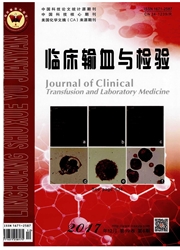

 中文摘要:
中文摘要:
目的掌握华东六省一市颅脑创伤(TBI)患者用血状况,为临床合理输血和及时救治患者提供理论依据。方法组织华东六省一市77家医院神经外科医生对经治的14948例颅脑创伤患者严格填写《颅脑创伤流行病学调查表》,收集2004年颅脑创伤住院患者输血与疾病的诊断、治疗及预后等相关因素的信息,获得的数据用SPSS13.0进行统计分析。结果14948例患者中经输血治疗2072例.其中男性1663例(80.26%),女性409例(19.74%),平均年龄(41.56±17.36)岁,15~44岁的占56.00%。平均每人输血1114.03ml,54%的患者输血盈在400~800ml。术中输血(70.08%)和失血性休克(23.75%)为输血主要原因。合并伤越重、颅内受损越重、颅脑手术越复杂者输血概率越大;颅脑损伤程度越重,输血景越多(x^2=103.44,P〈0.005);输血越多,引起感染等并发症的概率越大(x^2=1593.98,P〈0.001),预后越差(x^2=62.42,P〈0.005)。结论对颅脑患者早期应积极控制出血性休克,预防各种感染、休克等并发症,术中严格控制出血,术后及时纠正贫血。
 英文摘要:
英文摘要:
Objective To understand the characteristics of patients with traumatic brain injury(TBI) in eastern of China,to apply basic theory to guide reasonable transfusion and cure the patients in time in the clinic. Methods The neurosurgery doctors in the 77 hospitals were organized to fill in the epidemiological questionaires of 14 948 TBI patients,to collect the data of the relationship of blood transfusion with diagnosis ,therapeutics and prognosis,and the data were analyzed with SPSS 13.0 prospectively. Results 2 072 TBI patients were transfused in 14 948 patients, 1 663 male (80. 26% )and 409 female(19.74%),the average age was 41.56±17.36,56% of them were during 15-44 years old. The average blood transfusion volume was 1 114.03 ml,and 54% of the blood transfusion volume were 400-800 ml. Transfusion during the operation(70.08%) and hemorrhagic shock (23.75%) were the most important reasons, The more severity of the associated injury and intracal damage,more complicated operation,the more probability of transfusion. The more severity of head injury, the more blood transfusion volume be needed (x^2= 103. 44, P〈0. 005). The more transfusion, the more probability of neopathy such as infection(x^2=1 593.98,P〈0. 001),the worse prognosis(x^2=62.42,P〈0. 005). Conclusions Neurosurgery doctors should control the hemorrhage in the earlier period, and to prevent infection, shock ete beforehand. To control the hemorrhage in the operation properly, and to retrieve anaemia after operation.
 同期刊论文项目
同期刊论文项目
 同项目期刊论文
同项目期刊论文
 期刊信息
期刊信息
